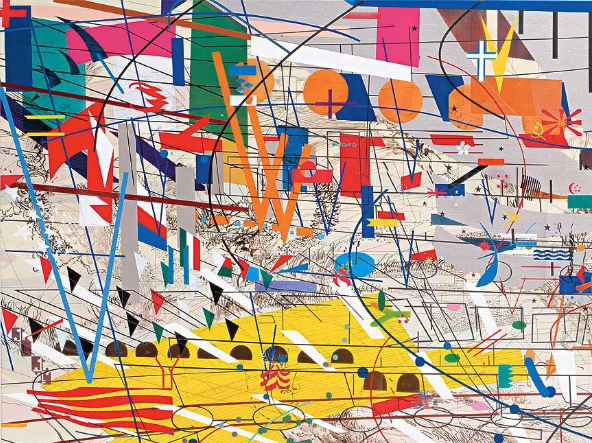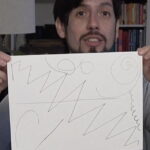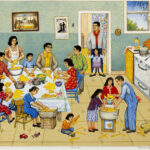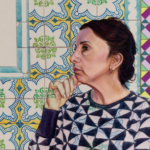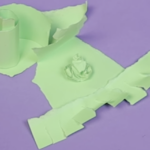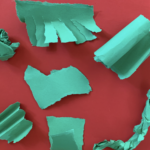Overview
In this unit, students find line, shape, color, and pattern in their homes, and continue to build line and shape recognition through close observation of select artworks. Students will draw and manipulate paper to explore these art elements. The unit culminates in an imaginary character collage.
Lessons
Materials and Tools
- Paper
- Pencil
- Crayons, markers, or colored pencils
- Glue
- Tape
Objectives
- Students will be introduced to four elements of art: line, shape, color, and pattern
- Students will look closely to find line, shape, color, and pattern, then draw each
- Students will explore collage by changing paper with their hands, making different arrangements, and creating an imaginary face
Student Outcomes
- Students will create artworks using different lines, shapes, colors, and patterns
- Students will tear, fold, twist, roll, crumple, and fringe paper with their hands
- Students will use their hands as tools to create facial features
Students will understand that:
- There are many different types of lines, and they can be found everywhere
- Shapes can be geometric or organic and can be found everywhere
- Patterns are made up of lines, shapes, and colors
- Hands can be a tool to change paper in different ways
Students will be able to:
- Use pencils to make a variety of lines
- Observe and draw different shapes that they find
- Put lines, shapes, and colors together to create patterns
- Change a flat piece of paper (two dimensional) into something that stands up (three dimensional).
Resources
Getty Museum
Expressing Emotions Through Art: using line, shape, and color
Getty Museum
Insect Anatomy and the Scientist as Illustrator: Studying and Drawing Insects
National Gallery of Art
Close Looking at Kandinsky – Color and Sound
National Gallery of Art
Elements of Art – Color (1st – 2nd Grade)
National Gallery of Art
Elements of Art – Line (1st – 2nd Grade)
Adaptations
For Students with Disabilities
- Use motions or bodies to make lines, shapes, and patterns
- Think about the sounds a line might make, or that one might hear in an artwork
- Use sounds to make repeating patterns
- Make patterns with manipulatives
- Draw lines and shapes on an iPad or in Google Classroom
- Use audio with visuals in student-facing lesson guides
For Multilingual Learners
- Emphasize repetition of new art vocabulary and spiral vocabulary. Activate students’ prior knowledge
- Use colors paired with vocabulary words to help with meaning
- Use icons or symbols to provide a visual for lines and shapes
- Use Total Physical Response (TPR) to have students draw lines and shapes in the air with their fingers or hands
- Use signposts to tell students what you are going to do next
- Chunk information and keep instructions concise
- Elicit information: ask questions, give students time to think about an answer, and extend the wait time
- Have multiple entry points: speaking, showing, and doing
- Use audio with visuals in student-facing lesson guides
Extensions
- Students can tear and cut a variety of lines and shapes out of construction paper. They can arrange them in different ways to create patterns. (Connect to math curriculum)
- Students can tear and cut a variety of shapes and arrange them to make an imaginary insect or animal. (Connect to science curriculum)
- Students can create a drawing of their imaginary character at home, thinking about an activity they do with their family. (Connect to Carmen Lomas Garza’s painting)
- Students can create drawings of buildings and houses in their neighborhood, using shapes. They can draw large and small shapes, make shapes that go inside other shapes, and create patterns. (Connect to 2nd Grade Social Studies curriculum about New York City and communities)
New York Teaching & Learning in Visual Arts Standards
Art Making: 2nd Grade Learning Indicators for Drawing and Collage
Create a drawing that demonstrates:
- Use of varied lines and shapes to convey expression and movement
- Exploration of lines such as straight, curved, bumpy, zigzag, spiral, looped, and broken
- Experimentation with geometric, organic, and invented shapes
Create a collage that demonstrates:
- Experimentation with tearing paper
- Exploration and expressive use of colored paper to represent a subject
- Imaginative placement of shapes
- Basic understanding of overlapping
Literacy in the Arts
- Looking at and Discussing Art
- Developing Visual Arts Vocabulary
- Reading and Writing About Art
- Problem Solving: Interpreting and Analyzing Art
Making Connections
- Recognizing the Societal, Cultural, and Historical Significance of Art; Connecting Art to Other Disciplines
- Observing and Interpreting the World
Community and Cultural Resources
- Cultural Institutions
- Online Resources and Libraries
Careers and Lifelong Learning
- Awareness of Careers in Visual Arts
- Art for Enjoyment and Lifelong Learning
NYS Learning Standards for the Arts
Artistic Process: Creating
Anchor Standards:
- Anchor Standard 1: Generate and conceptualize artistic ideas and work
- Anchor Standard 2: Organize and develop artistic ideas and work
- Anchor Standard 3: Refine and complete artistic work
Artistic Process: Presenting
Anchor Standards:
- Anchor Standard 4: Select, analyze, and interpret artistic work for presentation
- Anchor Standard 5: Develop and refine artistic techniques and work for presentation
- Anchor Standard 6: Convey meaning through the presentation of artistic work
Artistic Process: Responding
Anchor Standards:
- Anchor Standard 7: Perceive and analyze artistic work
- Anchor Standard 8: Interpret meaning in artistic work
- Anchor Standard 9: Apply criteria to evaluate artistic work
Artistic Process: Connecting
Anchor Standards:
- Anchor Standard 10: Relate and synthesize knowledge and personal experiences to inspire and inform artistic work
- Anchor Standard 11: Investigate ways that artistic work is influenced by societal, cultural, and historical context and, in turn, how artistic ideas shape cultures past, present, and future
Credits
Writing Team
Belinda Blum, Cynthia Chen, Bryan Melillo, Traci Talasco
Project Team
Belinda Blum, Nicola Giardina, Paul Urevitch, Andrea Burgay
Studio in a School NYC Team
Julie Applebaum, Senior Director
Hasna Muhammad, Ed.D., Chair, Board of Directors, Studio in a School Association
Alison Scott-Williams, President, Studio in a School NYC
NYC Department of Education OASP Team
Karen Rosner, Director of Visual Arts
Amber Lodman, Arts Program Manager
Kaitlin Trammell, Remote Arts Learning Partnership Project Coordinator
NYC Department of Education Visual Arts Teacher Team
Maria Bonilla, Amie Robinson, Susan Bricker, Lara Tyson
These educational materials were created through a partnership with Studio in a School NYC and The New York City Department of Education Office of Arts and Special Projects (OASP) and made possible by the generosity of The New York Community Trust.
Featured Image
Julie Mehretu. Stadia II. 2004, Carnegie Museum of Art, Pittsburgh
Copyright © 2023 Studio in a School NYC LLC

